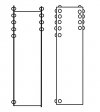Stevesopwith
Western Thunderer
Really super job!

...Do you have the 'Middleton Press' book', 'Branchline to Wantage' ? It contains about a dozen views...





...Pre-shading certainly gives you a bit of the willies when applied to a model! I must admit that I have started priming models in black now, and then highlighting in much lighter tones of the final colour...



The shading technique is interesting and will be useful on lots of models but I am not convinced it is right for this one. This is just my opinion so you don't have to take any notice.
In all the in service photos I have seen the body is clean and the paint is in good condition while the skirts are a bit dusty or muddy, as I would expect of a low speed tram operating beside unsealed roads. The dust/mud makes the black skirts look lighter. I can't see a change in colour or shading on the bodywork paint.
I think there is good evidence that the skirts were black, being several photographs taken after the loco was out of use showing the skirts dark and the body paint very faded. Two are in Higgins' The Wantage Tramway (plates 18 & 32) and another taken a bit later in Oxfordshire Railways in Old Photographs A Second Selection by Laurence Waters - see below. Also note the strap work on the body is the same dark colour as the skirts.
View attachment 83831
While looking into this I realised that Wantage Tramway No 5 is now painted a fetching shade of red and it is the second time in preservation that it has been painted red. Hopefully someone will know more about this but presumably it is because there were traces of red under the Swindon green. So now I wonder if the steam trams were also red? The amount of fading visible in the photo above, after being outside for only 3 or 4 years, would make sense with red paint but less so with green which tends to be more light fast. Higgins is inconclusive on the topic of colours, after stating the cars were painted a medium shade of olive green, continues with "The cars may have been painted brown or maroon at one time. The engines seem usually to have been painted in various shades of green."
Now I am wondering if my green painted model of No 4 should actually be red with black strap work.
Steve,The 1879 Matthews Patent drawing, in Vol 1 of David Gladwin's 'History of the British Steam Tram', includes a plan, as well as the side view used to produce the drawing above.
As Chris says, the wheels were inside the frames, while outside, in order, were the valve eccentrics, equal sized crank discs for each axle, the coupling rods, and lastly, the connecting rods. In service on the Wantage Tramway however, the coupling rods were removed, (as was also the case with the Hughes Loco). Photographic evidence indicates that the redundant forward crank disc was also removed. The drawing doesn't show a " smaller crank on the leading axle", its the original disc and crankpin.
I'm assuming the original patent drawing has had 4mm model related additions, ie. the larger than scale wheels, with a modified frame outline to suit, so the rear yellow disc is appropriate for a somewhat enlarged crank disc. However while the forward yellow ring might represent the front axle stub, there shouldn't be a crank or anything else on the end. The ring would be appropriate for the model's front axle bearing, as JB suggested.
There is one 'in service' photo showing the loco with it's side panels raised, probably for a bit of attention; all the many other photos show it running with the side panels closed, so I am inclined to echo Overseer's reservations, although I too have considered a similar arrangement when I build my second, upgraded version of this loco in 7 mm, because I can, and I'll know it's there.
Incidently, for what it's worth, I believe the Worsley etches incorrectly include a boiler tube access panel at both ends.
Steve.
Steve,I have often secretly thought about a Wantage Tram No 6 and the Hurst Nelson Car 5 in G3...
I look forward to an account of the builds.
Steve.

Now that would be something to see! I thought it was a 2-2-0.The loco will be as an 0-4-0 rather than the later 0-2-0 arrangement
